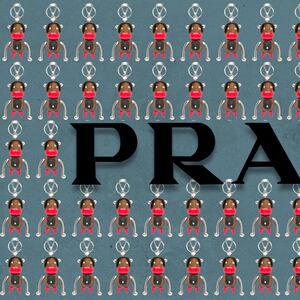Nearly three weeks after a black model refused to wear what she described as racist accessories during a runway show organized by New York City’s Fashion Institute of Technology, university administrators addressed the situation in a “Town Hall” meeting for students. But many are wondering if it’s too little, too late.
On Feb. 7, ten young alumni of the school’s master’s program staged their own fashion week presentation at Pier59 Studios in Chelsea. University leaders, including school President Dr. Joyce Brown, sat front row and watched models strut down the runway.
Photos taken of the event show one of them, Amy Lefevre, wearing a coral and white printed asymmetric dress created by F.I.T. alum Junkai Huang. The image, as Lefevre later told the New York Post, does not include the backstage drama that left her “shaking” and leaving the show nearly in tears.
ADVERTISEMENT
Huang, a 27 year-old designer from Qingdao, China, planned for his cast to wear prosthetic accessories purchased from Amazon, including oversized red lips and ears. Lefevre, who is black, found the style offensive.
“I stood there almost ready to break down, telling the staff that I felt incredibly uncomfortable with having to wear these pieces and that they were clearly racist,” the model told the Post. “I was told that it was fine to feel uncomfortable for only 45 seconds.”
One senior in the college’s Art History and Museum Professions program, who did not wish to be identified, told The Daily Beast outside today’s Town Hall that she was upset that Dr. Brown took action only after the show garnered negative press.
“She didn’t react until the New York Post wrote about it,” the student said. “The New York Post making your moral decisions for you? That’s ridiculous.” The student, who is black, added that she feels the school champions diversity “only at face value.”
“We’ve been talking about blackness and fashion for years. We have years of programming about this topic, and then this happened. Something is not sticking.”
Witnesses told the Post that Richard Thornn, the creative director of a British company which produced the show, seemed especially flippant backstage, and pressured Lefevre to wear the style.
In an email to The New York Times, Thornn said Ms. Lefevre had brought the issue to his attention right before the show, “in a very fractious backstage environment.”He added: “I was in the middle of a high intensity show and that is when I made a judgment, which I now know was a misjudgment, and for that I am extremely sorry.”
Anonymous students also said that the day before, they had told the MFA Fashion Design chair Jonathan Kyle Farmer that they were concerned about the accessories.
Dr. Brown, who has served as the college’s president since 1998, would release a lengthy statement 11 days later, on Feb. 18. She apologized for the “unfortunate and disturbing reaction to the show.”
“It is my position that all students must be afforded the safe space and freedom to learn and develop their voice, even if the voice is provocative to some,” she went on. “At the same time, I am deeply committed to creating a teaching and learning environment in which people are not offended or intimidated.”
Dr. Brown promised that in the following days, she would hold meetings with the school’s diversity council, faculty senate, UCE, and Student Government Association “to put in place safeguards to ensure that a situation like this will not happen again.”
Just three days later, the president’s office sent out another, more serious email. Along with hiring the law firm of Bond, Schoeneck, & King to investigate the incident, the school also took steps to absolve Huang of most responsibility in choosing the accessories.
“It appears. . .that the styling and accessorizing used in the show were provided to [Huang] rather than chosen at his discretion,” Dr. Brown wrote. “With this in mind, as the investigation unfolds, we would ask the community to hold us—rather than Junkai—accountable.”
The New York Times reported that Huang wanted his show to “explore the beauty in body parts that we don’t appreciate.” He wanted to “celebrate” and “embrace” traditionally “ugly” features.
As an international student, he claimed to not understand the even uglier implications of blackface. According to the Times, Farmer emailed Huang Amazon links for the prosthetics, suggesting he purchase the pieces instead of using ones he created himself.
Because of this, Farmer and Mary Davis, Dean of the School of Graduate Studies, were placed on administrative leave. (Farmer, Davis, and Huang did not respond to The Daily Beast’s request for comment.)
Dr. Brown also announced she would hold more talks with student leaders “to prepare for a Town Hall meeting with all FIT students.” The school’s press office and security guards declined to allow a Daily Beast reporter to sit in on the Town Hall, or make Dr. Brown available for an interview.
Through the school press office, Dr. Brown sent an emailed statement which read, “We have talked a lot in recent days about transparency and honesty and accountability. That is why today’s forum, which was organized by the FIT student government and leadership of the Black Student Union, was so important. Our college must be a place where students have the to speak up collectively and raise their questions and concerns. We are going to take what we learned today—and what we heard directly from students—and turn it into action.”
Loretta Lawrence Keane, Vice President of Communications and External Relations, would not speak at length. She said that members of F.I.T’s Black Student Union organized and held the event, and wanted it to be closed to press for the sake of privacy and creating “a safe space.” (The BSU did not respond to The Daily Beast’s request for comment by press time.)
On a windy day outside of the school’s Haft Theater, students told The Daily Beast the incident spoke to a larger issue of cultural insensitivity on campus, including what they see as sometimes-unchecked casual racism coming from professors.
“This is not the first instance where one of us has felt uncomfortable on campus because of something a professor has said or allowed,” Mercedes Delbrune, a senior, said. “It just opened up a bigger wound that’s been Band-Aided. All of us have felt some sort of [discomfort] that we just brushed away, because it was that one small instance.”
As the Vice President of the campus chapter of the Black Retail Action Group (BRAG), Delbrune sat in on initial meetings with Dr. Brown regarding what happened.
“They asked us how they can do better and not allow mistakes like that to happen again,” Delbrune explained. “They basically told us there was going to be an investigation going on, and they couldn’t really get rid of the professor [Farmer] at the time. At the time, we asked for proof of something going on, of someone actually caring. We asked that the professor be removed from the classroom.”
According to Delbrune, they also “gave ideas for procedures for fashion shows coming up next, and better procedures on hiring professors.” They called for “more diversity in the boardroom, for whoever is deciding what should be going on. Not just someone of color, but an Indian person, an Asian, all diversities and ethnicities should be in the room, so this doesn’t happen to anyone on campus.”
A member of the administration was there “writing stuff down,” or taking notes, according to Delbrune. “You don’t know if they are taking it into deep consideration,” she said. “They just kept repeating the same things, very generalized statements. They weren’t really answering questions.”
Alexandria White, a sophomore and treasurer of BRAG, was also at the meeting. She later attended part of the Town Hall, which students could pop in and out of over the course of three hours.
“At first, I didn’t think they were taking [what we said] into consideration, but [after the Town Hall], I think it’s starting to be productive,” White said. “They see how hurt people are, how offensive it was, how condescending. I do think they’re taking measures to hear us, having the president be more involved, because we want to hear from her, especially since she’s an African-American person. She’s responsible for the school. At first I didn’t agree with her statements and felt like it could have been stronger, but she’s actually listening, she cares, [and] that makes me feel better.”
According to White, “there was a mix of everyone,” in the audience of the Town Hall. “All types of people came and gave their feedback,” she said. “Black students, whites, Latinas. You had a white person [speak] up, she acknowledged her privilege, [and] talked about how it affected her. [It’s] interesting to see that perspective. Latinas spoke up about their point of view. Diversity is not just one race, it’s all races together.”
Students gave opinions on how the school can “not let this happen again,” and “better [itself] as an institution.” According to enrollment statistics from 2017, F.I.T has 7,341 students, and is overwhelmingly white. Forty-four percent are Caucasian, 19% are Latinx, 11% are Asian, and 9% are black. At the Town Hall, strengthening the Diversity Board Scholarship program was discussed.
Delbrune, who is from Far Rockaway, Queens, remembered an instance during her freshman year when a professor wanted to discuss the then-recent controversy of Marc Jacobs putting white models walking NYFW in dreadlocks.
“I had a professor ask, genuinely, if any of us felt uncomfortable about the situation,” Delbrune said. “It was me and another African-American person in the classroom. [The other student] said it was OK, and I stayed quiet. I didn’t feel like I had the courage to speak up and say, ‘That’s not OK.’ That’s what inspired me to join BRAG. I felt out of water.”
“We have great clubs like BRAG and BSU where you feel like you have a voice and safe space,” White agreed. “BSU did this amazing [Black History Month] exhibition, and then you have something like this [controversy] come out. It makes us go five steps backwards. It feels like a slap in the face.”
The anonymous Art History and Museum Professions student said, “I don’t think it’s enough to just give a platform for conversations, you have to enact what these conversations are saying into actual practice. Because they haven’t been doing that, then these things happen.”







